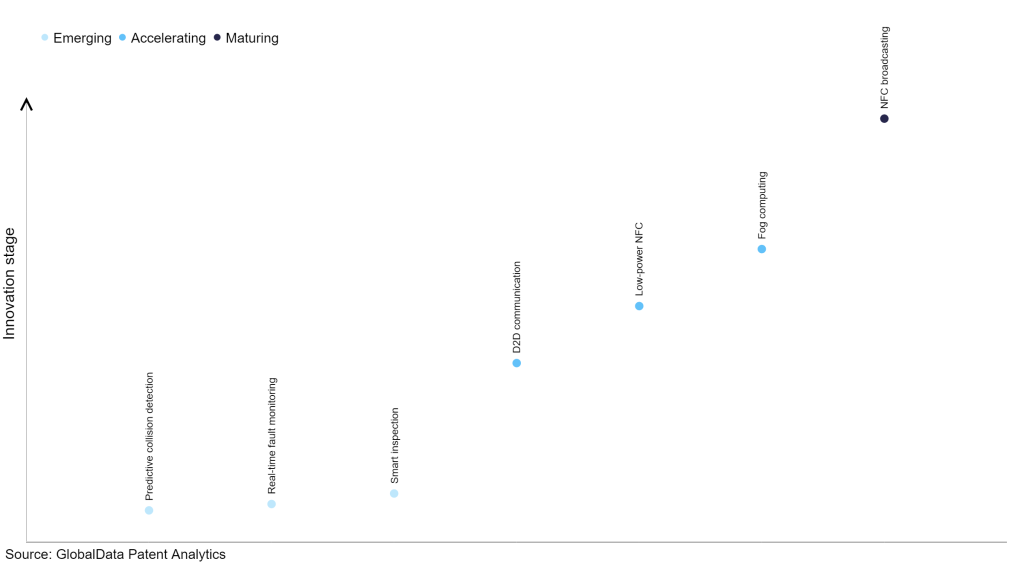The technology industry continues to be a hotbed of patent innovation. Activity is driven by the advancements in sensor technology, data processing capabilities and artificial intelligence and machine learning (ML) algorithms as well as increasing demand for advanced safety solutions, the rise of autonomous vehicles and rising demand for efficient traffic management. This has resulted in growing importance of technologies such as computer vision, sensor fusion, deep learning, and predictive analytics. These technologies work together to enhance situational awareness, improve response times, and ultimately prevent accidents, leading to safer environments and reduced risks. In the last three years alone, there have been over 1.5 million patents filed and granted in the technology industry, according to GlobalData’s report on Internet of Things in technology: predictive collision detection. Buy the report here.

Access deeper industry intelligence
Experience unmatched clarity with a single platform that combines unique data, AI, and human expertise.
However, not all innovations are equal and nor do they follow a constant upward trend. Instead, their evolution takes the form of an S-shaped curve that reflects their typical lifecycle from early emergence to accelerating adoption, before finally stabilizing and reaching maturity.
Identifying where a particular innovation is on this journey, especially those that are in the emerging and accelerating stages, is essential for understanding their current level of adoption and the likely future trajectory and impact they will have.
185+ innovations will shape the technology industry
According to GlobalData’s Technology Foresights, which plots the S-curve for the technology industry using innovation intensity models built on over 1.6 million patents, there are 185+ innovation areas that will shape the future of the industry.
Within the emerging innovation stage, predictive collision detection, real-time fault monitoring and smart inspection are disruptive technologies that are in the early stages of application and should be tracked closely. D2D communication, low-power NFC and fog computing are some of the accelerating innovation areas, where adoption has been steadily increasing. Among maturing innovation areas is NFC broadcasting, which is now well established in the industry.
Innovation S-curve for Internet of Things in the technology industry

Predictive collision detection is a key innovation area in Internet of Things
Predictive collision detection, utilized in video games and simulations, employs artificial intelligence to anticipate and avoid object collisions. By forecasting the path of each object, the system can assess the probability of a collision and initiate preventive measures. For instance, if two objects are on a collision course, the system can adjust the speed or position of one object to prevent the collision from happening.
GlobalData’s analysis also uncovers the companies at the forefront of each innovation area and assesses the potential reach and impact of their patenting activity across different applications and geographies. According to GlobalData, there are 120+ companies, spanning technology vendors, established technology companies, and up-and-coming start-ups engaged in the development and application of predictive collision detection.
Key players in predictive collision detection – a disruptive innovation in the technology industry
‘Application diversity’ measures the number of applications identified for each patent. It broadly splits companies into either ‘niche’ or ‘diversified’ innovators.
‘Geographic reach’ refers to the number of countries each patent is registered in. It reflects the breadth of geographic application intended, ranging from ‘global’ to ‘local’.
Intel is the leading patent filer in the predictive collision detection space. One of the company’s patents describes systems and methods that use cameras for enabling autonomous navigation features. One method involves capturing multiple images of the surrounding area using an image capture device, determining lane constraints on both sides of the user vehicle based on these images. This allows the user vehicle to pass another vehicle if it is in a different lane and abort the pass if the target vehicle is detected to be entering the user vehicle's lane before completion.
Other prominent patent filers in the space include Ford Motor and Mitsubishi Electric.
By geographic reach, Sumitomo Electric Industries leads the pack, followed by Intel and Nio. In terms of application diversity, Intel holds the top position, followed by Ford Motor and LG.
Internet of Things innovation in predictive collision detection can enhance safety and prevent accidents in various domains. By utilizing advanced algorithms to predict and prevent collisions between objects or vehicles, the technology can significantly reduce the risk of accidents and minimize potential damages. This innovation has the potential to revolutionize transportation systems, industrial operations, and even gaming experiences by providing real-time collision avoidance and improving overall safety standards.
To further understand the key themes and technologies disrupting the technology industry, access GlobalData’s latest thematic research report on Internet of Things.
Data Insights
From

The gold standard of business intelligence.
Blending expert knowledge with cutting-edge technology, GlobalData’s unrivalled proprietary data will enable you to decode what’s happening in your market. You can make better informed decisions and gain a future-proof advantage over your competitors.







